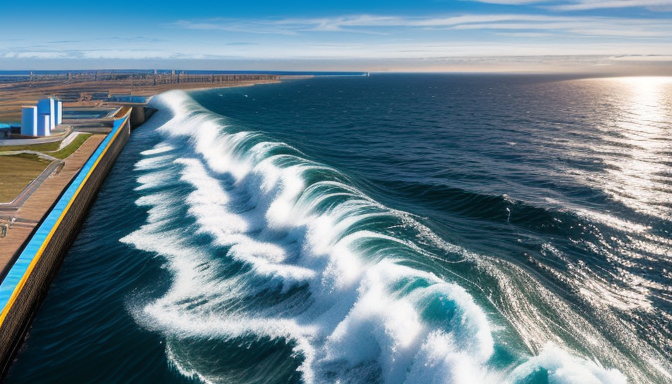Wave energy is not just a buzzword; it’s a revolutionary force that promises to transform the way we think about renewable energy. Imagine harnessing the **power of the ocean**—the very waves that crash against our shores—into a sustainable and clean electricity source. Sounds incredible, right? Wave energy is derived from the motion of ocean waves, and it has the potential to light up homes, power industries, and even charge electric vehicles. As we face the looming threat of climate change, the urgency to find alternative energy sources has never been greater.
In essence, wave energy works by capturing the kinetic and potential energy generated by the movement of waves. This energy is then converted into electricity using various technologies. Think of it like capturing the energy from a bouncing ball; the more forceful the bounce, the more energy you can harness. With advancements in technology, we are now able to convert these ocean waves into usable power more efficiently than ever before.
But why should we care about wave energy? Well, for starters, it offers a **cleaner alternative** to fossil fuels. By tapping into this renewable resource, we can significantly reduce our carbon footprint and contribute to a healthier planet. Moreover, wave energy systems are often installed offshore, which minimizes their impact on land use and can help protect coastal ecosystems.
As we look to the future, the potential of wave energy is immense. It could play a critical role in diversifying our energy mix and ensuring a stable and sustainable energy supply for generations to come. The question is, are we ready to embrace this powerful force of nature? With the right policies and investments, wave energy could very well be the key to a greener, more sustainable future.
The Basics of Wave Energy
Wave energy is a fascinating concept that taps into the power of our oceans. Imagine harnessing the rhythmic dance of waves to generate electricity—it’s like capturing the energy of a heartbeat! But how does this all work? At its core, wave energy involves converting the kinetic and potential energy of ocean waves into electrical energy. This is achieved through various technologies designed to capture and transform that energy efficiently.
The science behind wave dynamics is equally intriguing. Waves are formed by the wind as it blows across the surface of the sea, creating energy that can be captured. When these waves rise and fall, they create a powerful force that can be harnessed. The most common technologies used in wave energy conversion include:
- Point Absorbers: These devices float on the surface and move with the waves, converting motion into energy.
- Oscillating Water Columns: These structures utilize the movement of water to push air through turbines, generating power.
- Overtopping Devices: These capture waves in a reservoir and release the water through turbines to produce energy.
By understanding these technologies, we can appreciate how wave energy is not just a dream but a tangible reality. It offers a sustainable solution to our energy needs, tapping into a resource that is abundant and renewable. As we delve deeper into this subject, it becomes clear that the ocean is not just a vast body of water, but a treasure trove of energy waiting to be unlocked!

Technological Innovations
Wave energy is not just a buzzword; it’s a revolutionary force in the renewable energy sector. The technological advancements in this field are nothing short of astounding. Imagine harnessing the power of the ocean’s waves to light up our homes and cities! With the development of sophisticated devices that can convert wave motion into electricity, we are on the brink of a new era in energy production.
One of the most exciting innovations is the Oscillating Water Column (OWC). This device captures the energy of waves as they rise and fall, pushing air through a turbine to generate electricity. It’s like having a small wind turbine underwater! In addition, the Point Absorber Buoy is another remarkable technology that floats on the surface, capturing the vertical motion of waves. These buoys can be strategically placed to maximize energy capture, making them an efficient choice for wave energy farms.
Moreover, the integration of smart technology is enhancing the efficiency of wave energy systems. By utilizing advanced sensors and IoT devices, operators can monitor performance in real-time and make necessary adjustments to optimize energy output. This proactive approach not only increases efficiency but also reduces maintenance costs.
In terms of scalability, wave energy technology is evolving rapidly. As we look at the future, the potential for large-scale wave energy farms is becoming more feasible. The table below illustrates some of the key technological innovations in wave energy:
| Technology | Description | Benefits |
|---|---|---|
| Oscillating Water Column | Uses wave motion to push air through a turbine. | High energy conversion efficiency. |
| Point Absorber Buoy | Floats on the surface, capturing vertical wave motion. | Scalable and adaptable to different marine environments. |
| Attenuator | A floating structure that moves with waves to generate power. | Can be deployed in arrays for enhanced energy capture. |
With these innovations, the future of wave energy looks promising. As we continue to refine these technologies, we may soon see wave energy becoming a significant player in our global energy landscape, paving the way for a cleaner, more sustainable future.
Environmental Impact
When we think about the future of energy, it’s hard not to get excited about the potential of wave energy. This renewable resource not only promises to light up our homes but also does so while being kinder to our planet. Imagine harnessing the power of the ocean, where waves crash and surge, to generate clean electricity! However, like any energy source, it’s crucial to consider its .
Wave energy presents a cleaner alternative to traditional fossil fuels, which are notorious for their harmful emissions and ecological footprint. By tapping into the relentless energy of the ocean, we can significantly reduce our reliance on polluting energy sources. But what does this mean for marine ecosystems? It’s a valid concern, as the installation of wave energy converters and other infrastructure can disrupt local habitats.
Research indicates that while the environmental footprint of wave energy systems is generally lower than that of fossil fuels, there are still potential risks to marine life. For instance, the noise generated during installation and operation can affect marine mammals, while the physical presence of devices may alter local currents and sediment patterns. To mitigate these impacts, developers are focusing on environmentally-friendly designs and conducting thorough environmental assessments.
In summary, while wave energy holds great promise for a sustainable future, it’s essential to balance its benefits with careful consideration of its environmental effects. By investing in research and innovative technologies, we can ensure that wave energy not only powers our homes but also protects the beautiful ecosystems that make our planet unique.

Economic Viability
When we talk about the of wave energy, we’re diving into a pool of potential that’s as deep as the ocean itself. Imagine harnessing the power of waves to not only light up homes but also to create jobs and stimulate local economies. The initial investment in wave energy infrastructure might seem daunting, but the long-term benefits can outweigh these costs significantly.
One of the most appealing aspects of wave energy is its low operational costs. Once the infrastructure is in place, the ongoing expenses are relatively minimal compared to fossil fuels. This is because wave energy systems can generate electricity continuously, taking advantage of the ocean’s relentless motion. Moreover, as technology advances, the cost of production continues to decline, making wave energy increasingly competitive.
To further illustrate this, consider the following table that compares the costs associated with wave energy versus traditional energy sources:
| Energy Source | Initial Investment | Operational Costs | Environmental Impact |
|---|---|---|---|
| Wave Energy | High | Low | Minimal |
| Fossil Fuels | Medium | High | High |
Additionally, government incentives and funding opportunities are becoming more prevalent, encouraging investments in renewable energy. These initiatives can significantly reduce the financial burden on developers and promote further research into wave energy technologies. With the right policies in place, wave energy could become a cornerstone of sustainable development, providing a reliable energy source while contributing to economic growth.
In essence, the economic viability of wave energy is not just about numbers; it’s about creating a sustainable future that benefits both the planet and its people. So, the next time you hear the waves crashing on the shore, remember that they hold the potential to power our world in ways we are just beginning to explore.
Future Prospects
As we gaze into the horizon of energy production, wave energy stands out as a beacon of hope and innovation. The potential it holds for the future is not just a dream; it’s a reality that’s slowly but surely taking shape. Imagine harnessing the power of the ocean’s waves, a natural phenomenon that has existed for millennia, to fuel our homes and industries. Isn’t that exciting? With advancements in technology, wave energy is poised to become a significant player in the global energy mix.
Recent studies indicate that wave energy could contribute up to 10% of the world’s electricity by 2050. This is an ambitious target, but with the right investments and policy support, it’s entirely achievable. The key lies in overcoming the challenges associated with the technology, including efficiency and cost-effectiveness. Investing in research and development is crucial, and governments worldwide are beginning to recognize this necessity.
Moreover, the integration of wave energy into existing energy systems can provide a more stable and reliable energy source. Unlike solar or wind energy, wave energy is more predictable and consistent, making it an attractive option for energy planners. However, to fully realize this potential, we need to address some critical factors:
- Infrastructure Development: Building and maintaining wave energy converters in marine environments can be challenging and costly.
- Environmental Regulations: Ensuring that wave energy projects do not harm marine ecosystems is essential for sustainable development.
- Public Awareness: Increasing awareness and understanding of wave energy’s benefits can drive consumer acceptance and investment.
Looking ahead, the collaboration between governments, researchers, and private companies will be vital. By fostering a supportive policy environment and encouraging innovation, we can unlock the full potential of wave energy. The ocean is calling, and it’s time we answered!
Frequently Asked Questions
- What is wave energy?
Wave energy is the energy harnessed from the movement of ocean waves. It uses various technologies to convert the kinetic and potential energy of waves into electricity, providing a renewable source of power.
- How does wave energy technology work?
Wave energy technology typically involves devices like buoys or oscillating water columns that capture wave motion. These devices convert the up and down movement of waves into mechanical energy, which is then transformed into electrical energy.
- Is wave energy environmentally friendly?
Yes, wave energy is considered a cleaner alternative to fossil fuels. It has a lower carbon footprint and can help reduce greenhouse gas emissions. However, it’s important to evaluate its impact on marine ecosystems.
- What are the economic benefits of wave energy?
Investing in wave energy can create jobs, stimulate local economies, and reduce reliance on imported fossil fuels. Additionally, as technology advances, the costs associated with wave energy are expected to decrease, making it more economically viable.
- What is the future of wave energy?
The future of wave energy looks promising as advancements in technology continue. With supportive policies and investments, wave energy could significantly contribute to the global energy mix, helping to achieve sustainable energy goals.

